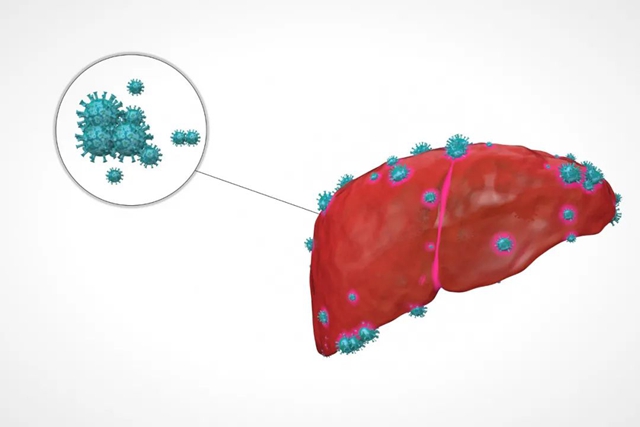Why unexplained childhood hepatitis outbreak in UK?
- Engineered Soybeans with Pig Protein: A Promising Alternative or Pandora’s Dish?
- Severe Fever with Thrombocytopenia Syndrome (SFTS): A Tick-Borne Threat with High Mortality
- Why Isolating Bananas Extends Their Shelf Life?
- This common vitamin benefits the brain and prevents cognitive decline
- New report reveals Nestlé adding sugar to infant formula sold in poor countries
- Did Cloud Seeding Unleash a Deluge in Dubai?
Why unexplained childhood hepatitis outbreak in UK?
- Red Yeast Rice Scare Grips Japan: Over 114 Hospitalized and 5 Deaths
- Long COVID Brain Fog: Blood-Brain Barrier Damage and Persistent Inflammation
- FDA has mandated a top-level black box warning for all marketed CAR-T therapies
- Can people with high blood pressure eat peanuts?
- What is the difference between dopamine and dobutamine?
- How long can the patient live after heart stent surgery?
On 31 March 2022, Scotland first reported five cases of severe hepatitis of unknown cause in children. The World Health Organization (WHO) issued guidance on childhood hepatitis of unknown cause on April 15, defining confirmed cases, suspected cases and epidemiologically relevant cases.
As of April 21, 169 cases of unexplained hepatitis in children, ranging from 1-month-old to 16-year-old, have been reported in 12 countries.

Why unexplained childhood hepatitis outbreak in UK?
The clinical manifestations of unexplained childhood hepatitis are acute hepatitis , aspartate aminotransferase (AST) or alanine aminotransferase (ALT) > 500 IU/L, most children have jaundice, nausea, abdominal pain, fatigue, lethargy and gastrointestinal symptoms , including diarrhea and vomiting.
Most patients were afebrile. Seventeen received liver transplantation and at least one death was reported . Considering the epidemiological characteristics and the clinical characteristics of the children, infectious factors are more likely to cause the disease.
Laboratory findings in all cases ruled out hepatitis A, B, C, D, and E, and suggested that adenovirus may be associated with unexplained childhood hepatitis, but other infectious or environmental factors could not be completely ruled out .
This article introduces the development of this unexplained childhood hepatitis and its possible etiology. There is an imported risk of the disease, and every country should prepare for it early.
Outbreaks of unexplained hepatitis among children in the United Kingdom, the United States and other countries
On March 31, 2022, Public Health Scotland (PHS) received reports that the Glasgow Royal Hospital had treated 5 children with severe hepatitis of unknown cause in the past 3 weeks. The children were 3 to 5 years old. Healthy body. Before this, there were usually fewer than four children with unexplained hepatitis a year in Scotland.
However, as of April 12, PHS has found a total of 13 confirmed cases (children aged 1-10 years, median 3.9 years old) , one of which can be traced back to January 11, 2022, and the remaining 12 cases. Appears from March 4th to April 7th. On April 14, the results of the PHS questionnaire showed that 2 of the 13 cases were epidemiologically linked.
On the other hand, in November 2021, a large children’s hospital in Alabama, USA notified the public health department of 5 pediatric patients with obvious liver damage, and further investigation identified 4 additional children with unexplained hepatitis.
The total number reached 9 cases. The visits for these cases were from October 2021 to February 2022. All the children were healthy before the onset of illness and denied a history of severe acute respiratory syndrome coronavirus 2 (SARS-CoV-2) infection.
On April 15, WHO issued a briefing and guidance on acute hepatitis of unknown etiology in children . Definition [WHO 20220415].
Confirmed case :
Since January 1, 2022, with acute hepatitis (not caused by hepatitis A, B, C, D, E virus) and aspartate aminotransferase (AST) or alanine aminotransferase (ALT) > 500 IU/L for children 10 years and younger .
Suspected cases :
Children aged 11-16 years with acute hepatitis (not caused by hepatitis A, B, C, D, and E viruses) and AST or ALT >500 IU/L since January 1, 2022 .
Epidemiologically relevant cases :
Patients with acute hepatitis (not caused by hepatitis A, B, C, D, and E viruses) since January 1, 2022 and who have had close contact with a confirmed case .
As of April 21, 169 confirmed cases have been reported in 12 countries, including 114 in the UK, 13 in Spain, 12 in Israel, 9 in the US, 6 in Denmark, 5 in Ireland, 4 in the Netherlands, 4 in Italy, Norway and France have two cases each, Romania and Belgium one each.
The children were 1 month to 16 years old. Seventeen received liver transplantation and at least one died.
The clinical manifestations of the children are acute hepatitis, elevated blood transaminase levels (AST or ALT > 500 IU/L) , and many children have jaundice, nausea, abdominal pain, fatigue, and lethargy.
Some children reported gastrointestinal symptoms, including diarrhea and vomiting, in the weeks before admission. Most children have no fever.
Etiological Analysis of Hepatitis in Children of Unknown Cause
None of the children with unexplained hepatitis in the UK had been vaccinated against SARS-CoV-2, so a direct association of this vaccine with unexplained childhood hepatitis can be ruled out .
The investigation team of the British health department collected detailed information on the children’s diet, drinking water and personal daily habits through questionnaires, and found no exposure to common poisoning factors.
Although toxicological investigations are still ongoing, it is speculated based on the epidemiological characteristics and clinical characteristics of the cases that infectious factors are more likely to cause the disease.
Laboratory findings in all reported cases ruled out hepatitis A, B, C, D, and E. Among the 169 cases announced by WHO, 74 children tested positive for adenovirus, of which 18 were identified as adenovirus type 41. SARS-CoV-2 was detected in 20 children, and 19 patients were co-infected with adenovirus and SARS-CoV-2 .
Of the 13 previously reported cases in Scotland, 11 were tested for adenovirus and 5 were positive; 5 had been or are currently infected with SARS-CoV-2. In addition, norovirus, rhinovirus, enterovirus, parainfluenza virus, human cytomegalovirus, human coronavirus NL63 and Sapporo virus were also detected in individual cases (all no more than 2 cases).
Adenovirus was commonly detected in reported cases in the United States, with five samples showing adenovirus type 41 by sequencing.
Laboratory test results suggest that adenovirus may be associated with unexplained childhood hepatitis, but other infectious etiologies or environmental factors cannot be completely ruled out. Metagenome sequencing and sequence analysis are ongoing, and results have not yet been published.
Although it is currently speculated that adenovirus infection may be one of the potential factors leading to severe acute hepatitis in this child, the severity of its clinical symptoms cannot be explained . Adenovirus is a common human pathogen. It is a double-stranded DNA virus without an envelope.
It is divided into 7 subgroups (A~G subgroups) with more than 50 serotypes. It is mainly transmitted from person to person through the respiratory tract and contact.
Often cause respiratory diseases. Different serotypes of adenovirus can cause other diseases such as gastroenteritis (inflammation of the stomach or intestines), conjunctivitis (red eye), and cystitis.
Adenovirus types 40 and 41 are mainly transmitted through the digestive tract (see Table 1). Adenovirus 41 infection usually presents with diarrhea, vomiting, and fever with respiratory symptoms. Adenovirus infection is usually self-limiting, causing only mild illness or symptoms.
Acute hepatitis due to adenovirus infection is uncommon, especially in immunocompetent children , although there have been case reports of adenovirus infection in immunocompromised children. It is unclear whether adenovirus 41 infection was the cause of this acute hepatitis in healthy children.
At present, it is speculated that the possible causes of this unexplained childhood hepatitis are as follows:
- It is a new variant of a known virus, possibly adenovirus, but it cannot rule out the possibility of other pathogens , such as variants of coronavirus, rhinovirus, enterovirus, parainfluenza virus, etc. If it is a new variant of adenovirus, it is worth paying attention to whether it is related to the recombination and mutation of adenovirus under the selection pressure that may occur after large-scale vaccination of adenovirus vector vaccine .
- Epidemic prevention and control during the COVID-19 epidemic may result in reduced exposure of some young children to common pathogens, resulting in a different development of their immune systems than children of the same age before the COVID-19 epidemic . When young children are subsequently infected with common pathogens such as adenovirus, they will produce immune responses or disease manifestations that are different from those of their peers in the past; it is also possible that on the basis of previous SARS-CoV-2 infection, subsequent infection with adenovirus or other viruses, or SARS-CoV -2 Unusual immune responses or disease manifestations in cases of co-infection with adenovirus or other viruses.
- There is a new pathogen that has not yet been discovered .
- Non-infectious factors , such as environmental toxins, drugs, etc., cannot be completely ruled out.
According to epidemiological investigation information and clinical laboratory examination results, it is speculated that the unexplained childhood hepatitis occurring in many countries in Europe and the United States is likely to be caused by an infectious pathogen, and the source of infection is temporarily confirmed cases, suspected cases and epidemiologically related case.
According to current reports, confirmed cases are children under the age of 16, but in the absence of an identified pathogen, it cannot be ruled out that people of other age groups are also infected with related pathogens.
According to WHO’s forecast, the number of unexplained childhood hepatitis cases may continue to increase in the future.
With the publication of more case data and laboratory test results, many questions about the etiology of unexplained childhood hepatitis may be answered, so that more Targeted prevention and control measures are formulated.
Expert comments: (Why unexplained childhood hepatitis outbreak in UK?)
Cases of unexplained hepatitis occur every year and often refer to liver damage without a known hepatitis virus or with a known cause, which is not uncommon in children.
However, the unexplained hepatitis that WHO is concerned about this time has the characteristics of clustered disease, and the incidence rate is higher than in previous years.
In this case, it is reasonable to consider the risk of infectious diseases. It has been found that there is a certain correlation with adenovirus infection. But adenovirus infection is a very common phenomenon that can cause pneumonia or diarrhea. Why are there so many cases of severe hepatitis this year, and only in children?
At present, it is speculated that it is a long-term COVID isolation. Children have not been exposed to this virus for a long time, and sudden contact will cause relatively serious immune damage.
This speculation is consistent with the phenomenon that emerging infectious diseases tend to be heavier in the early stage of disease outbreaks.
If this is the cause, rather than a new virus that has not been discovered before, the subsequent effects of this unexplained hepatitis will gradually decline, but we also need to be vigilant about unknown pathogens, even if this new infection occurs. The probability of a pandemic is not high.
In addition, the current definition of a confirmed case is constantly being updated as awareness grows.
Why unexplained childhood hepatitis outbreak in UK?
(source:internet, reference only)
Disclaimer of medicaltrend.org
Important Note: The information provided is for informational purposes only and should not be considered as medical advice.



